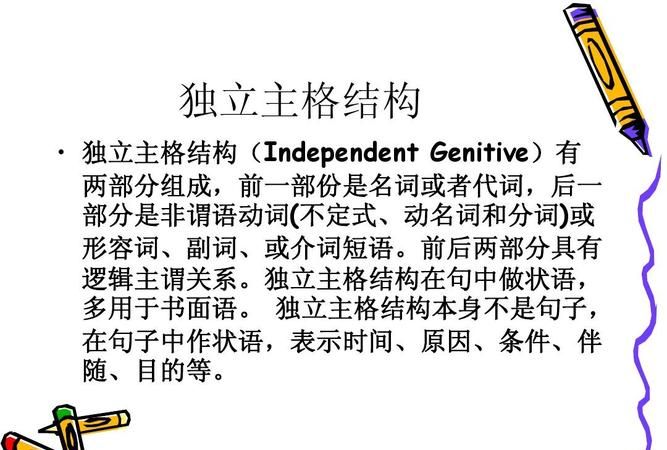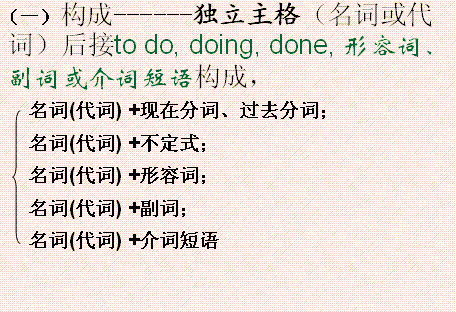本文目录
独立主格用法详解
独立主格
1独立主格结构的构成:名词(代词)+现在分词、过去分词;
名词(代词)+形容词;
名词(代词)+副词;
名词(代词)+不定式;
名词(代词) +介词短语构成。
独立主格结构的特点:
1)独立主格结构的逻辑主语与句子的主语不同,它独立存在。
2)名词或代词与后面的分词,形容词,副词,不定式,介词等是主谓关系。
3)独立主格结构一般有逗号与主句分开。
例如: The test finished, we began our holiday. = When the test was finished, we began our holiday. 考试结束了,我们开始放假。
The president assassinated, the whole country was in deep sorrow. = After the president was assassinated, the whole country was in deep sorrow. 总统被谋杀了,举国上下沉浸在悲哀之中。
Weather permitting, we are going to visit you tomorrow. 天气允许,我们明天去看你。
This done, we went home. 工作完成后,我们才回家。
The meeting gone over, everyone tired to go home earlier. 会议结束后,每个人都想早点回家。
He came into the room, his ears red with cold. 他回到了房子里,耳朵冻得红通通的。
He came out of the library, a large book under his arm. 他夹着本厚书,走出了图书馆
2 with的复合结构作独立主格
表示伴随情况时,既可用分词的独立结构,也可用with的复合结构:with +名词(代词)+现在分词/过去分词/形容词/副词/不定式/介词短语。例如:
He stood there, his hand raised. = He stood there, with his hand raise.他举手着站在那儿。
典型例题
The murderer was brought in, with his hands ___ behind his back。
A. being tied B. having tied C. to be tied D. tied
答案D. with +名词(代词)+分词+介词短语结构。当分词表示伴随状况时,其主语常常用with来引导。由于本句中名词"手"与分词"绑"是被动关系,因此用过去分词,选D.
注意:
1) 独立主格结构使用介词的问题: 当介词是in时,其前后的两个名词均不加任何成分(如物主代词或冠词),也不用复数。但 with 的复合结构不受此限制。例如:A robber burst into the room, knife in hand.(hand前不能加his)劫匪冲进房间,手里拿着刀。
2) 当表示人体部位的词做逻辑主语时,及物动词用现在分词,不及物动词用过去分词。例如:
He lay there, his teeth set, his hand clenched, his eyes looking straight up.
他躺在那儿,牙紧咬,双手握拳,两眼直勾勾看着上面。
典型例题:
Weather___, we”ll go out for a walk.
A permitted B permitting C permits D for permitting
答案B. 本题中没有连词,它不是复合句,也不是并列句。 句中使用了逗号,且we 小写,可知其不是两个简单句。能够这样使用的只有独立主格或with的复合结构。据此判断,本句中使用的是独立结构,其结构为:名词+分词。 由于permit在这里翻译为”天气允许”,表主动,应用现在分词,故选B。
如果不会判断独立结构作状语的形式,不妨将句子改为条件句,例如本句改为If weather permits, we”ll go out for a walk. 然后将if 去掉,再将谓语动词改为非谓语动词即可

独立主格结构用法详解
一、独立主格结构的概念
独立主格结构(Absolute Structure)是由名词或代词加上分词等构成的一种独立结构,用于修饰整个句子。独立主格结构中的名词或代词与其后的分词等构成逻辑上的主谓关系。这种结构与主句不发生句法上的联系,它的位置相当灵活,可置于主句前、主句末或主句中,常由逗号将其与主句分开。需特别注意的是,独立主格结构与主句之间不能使用任何连接词。
二、独立主格结构基本构成形式
名词(代词)+现在分词(过去分词;形容词;副词;不定式;名词;介词短语)
1. 名词(代词)+现在分词
Night enshrouding the earth, nobody could make out what the dark mass was from a distance.
黑夜笼罩大地,谁也看不清远处黑压压的一片是什么东西。
There being no bus, we had to walk home.
由于没有公共汽车,我们只好走回家。
2. 名词(代词)+过去分词
The workers worked still harder, their living conditions greatly improved.
由于工人们的生活条件大大提高,他们工作得更起劲了。
He was listening attentively in class, his eyes fixed on the blackboard.
他上课专心听讲,眼睛紧盯着黑板。
3. 名词(代词)+不定式
在“名词/代词+动词不定式”结构中,动词不定式和它前面的名词或代词如果存在着逻辑上的主谓关系,动词不定式则用主动的形式;如果是动宾关系,则用被动形式。
The four of us agreed on a division of labor, each to translate a quarter of the book.
我们四人同意分工干,每人翻译全书的四分之一。
Many trees, flowers, and grass to be planted, our newly-built school will look even more beautiful.
种上许多的树、花和草后,我们新建的学校看上去将更美。
4. 名词(代词)+形容词
The Trojans asleep, the Greek soldiers crept out of the hollow wooden horse.
特洛伊人睡着了,于是希腊士兵从中空的木马里悄悄爬了出来。
Computers very small, we can use them widely.
电脑虽小,我们却能广泛地利用它们。
5. 名词(代词)+副词
The meeting over, our headmaster soon left the meeting room.
散会了,校长很快就离开了会议室。
The lights off, we could not go on with the work.
灯熄了,我们不能继续工作了。
6. 名词(代词)+名词
His first shot failure,he fired again.
他第一枪没击中,又打了一枪。
Two hundred people died in the accident, many of them children.
两百人死于事故,其中有许多儿童。
7. 名词(代词) +介词短语
He lay at full length upon his stomach,his head resting upon his left forearm.
他的脊背朝天,四肢伸展,头枕着左臂,直挺挺地趴伏着。
Every afternoon a very old woman hobbled past the old house,a vast load of firewood on her back.
每天下午,一个背着一大背柴禾的老妇人都会从那间破旧的房屋前蹒跚着走过。
三、with,without 引导的独立主格结构
with ( without)+宾语(名词/代词)+宾语补足语,宾语通常由名词或代词充当,但代词一定要用宾格。上文的独立主格结构的几种情况都适用于此结构。
The girl hid her box without anyone knowing where it was.
小女孩把盒子藏了起来,没有人知道它在哪里。(without +名词/代词+动词的-ing形式)
Without a word more spoken, she left the meeting room.
她没再说什么话就离开了会议室。(without+名词/代词+动词的-ed形式)
The kid feels excited with so many places of interest to visit.
有这么多的名胜可参观,小孩很激动。(with+名词/代词+动词不定式)
The boy was walking, with his father ahead.
父亲在前,小孩在后走着。(with+名词/代词+副词)
He stood at the door, with a computer in his hand. 或He stood at the door, computer in hand.
他站在门口,手里拿着一部电脑。(with+名词/代词+介词短语)
With his son so disappointing, the old man felt unhappy.
由于儿子如此令人失望,老人感到很不快乐。(with+名词/代词+形容词)
在with (without) 的复合结构中,多数情况下with 能省略,但without 不能省略。
四、独立主格结构的句法功能
独立主格结构在句中一般作状语,表示时间、条件、原因、伴随状况等,还可以作定语。
1. 作时间状语
My shoes removed,I entered a low-ceilinged room,treading cautiously on the soft tatami matting.
我脱掉鞋子后,走进一间屋顶很低的房间,小心翼翼地踩在柔软的塌塌米垫子上。
The governor pondering the matter,more strikers gathered across his path.
总督思考问题时,更多的罢工工人聚集在他要通过的路上。
2. 作条件状语
Weather permitting,they will go on an outing to the beach tomorrow.
如果天气允许的话,他们将在明天组织一次海滨郊游。
Such being the case,you have no grounds for dismissing him.
如果情况如此的话,你没有理由解聘他。
3. 作原因状语
The boy leading the way, we had no trouble finding the strange cave.
由那个男孩带路,我们很容易就找到了那奇怪的洞。
There being no further business to discuss, we all went home.
没有别的事可讨论,我们都回家了。
4. 作伴随状语或补充说明
I took my ticket,and marched proudly up the platform,with my cheeses,the people falling back respectfully on either side.
我拿着车票还有我的奶酪,雄赳赳气昂昂地跨步走向月台。人们似乎很尊敬我,纷纷向两边退去。
Ten students entered for the competition, the youngest a boy of 12.
十个学生报名参加了这次竞赛,年纪最小的是个12岁的男孩。
5. 作定语,独立主格结构作定语其功能相当于一个定语从句。
He is the person with a lot of questions to be settled.
他就是有许多问题要解决的那个人。
He was walking along the road without any street lights on its both sides.
他走在一条两边没有路灯的马路上。
Close to the bank I saw deep pools, the water blue like the sky.
靠近岸时,我看见几个深池塘,池水碧似蓝天。
五、独立主格结构注意事项
1. 独立主格结构多用于书面语,尤其是描述性语言中,在口语和非正式文体中,一般用从句或两个句子来代替。独立主格结构的逻辑主语与句子的主语不同,它独立存在,名词或代词与后面的分词等逻辑上是主谓关系,独立主格结构一般有逗号与主句分开。
The president assassinated, the whole country was in deep sorrow.
总统被谋杀了,举国上下沉浸在悲哀之中。
2. 动词不定式表示动作没有发生或即将发生,动词-ed形式表示动作已经结束,动词-ing形式往往表示动作正在进行。
The manager looks worried,many things to settle.
经理看上去很着急, 有这么多的事情要处理。(事情还没有处理,而且是由经理本人来处理,用不定式to settle,表示将来的时间)
The manager looks relaxed, many things settled.
许多事情已经处理好了,经理看上去很轻松。(事情已经处理好了,用过去分词settled表示动作已经结束)
The food being cooked, the boy was watching TV.
小孩一边做饭,一边看电视。(两个动作同时进行)
3. 独立主格结构介词使用的问题
当介词是in时,其前后的两个名词均不加任何成分(如物主代词或冠词),也不用复数。但 with 的复合结构不受此限制。
A robber burst into the room, knife in hand. ( hand前不能加his)
劫匪手里拿着刀闯进房间。
当表人体部位的词做逻辑主语时,及物动词用现在分词,不及物动词用过去分词。
He lay there, his teeth set, his hands clenched, his eyes looking straight up.
他躺在那儿,牙关紧闭,双拳紧握,两眼直视上方。
4. 独立主格结构与独立成分的异同
有些分词短语可以独立存在,在句子中没有逻辑上的主语,作为习惯用法。这些短语有:Generally speaking (总的说来),Frankly speaking (坦率地说),Judging from (从……判断),Supposing (假设),等等。
Generally speaking, the rule is very easy to understand.
总的说来,这条规则很容易懂。
Judging from what he said, he must be an honest man.
由他所说的来判断,他一定是一个诚实的人。
有些固定短语是带 to 的不定式,表明说话人的立场或态度,在句中作独立成分。这些短语有:to be honest(老实说),to be sure (确实),to tell you the truth (说实话),to cut a long story short (长话短说),to be frank (坦率地说),to make matters / things worse (更糟糕的是),等等。
To tell you the truth, I made a mistake in the word spelling.
说实话,我犯了一个拼写错误。
To make things worse, many of the men have gone off to cities in search of higher pay, leaving women from nearby villages to carry on with the work.
情况更糟的是,许多男人都去城市找工资较高的工作,而留下附近村庄的妇女来继续承担修复工作。
5.独立主格结构与分词短语都可以转换为状语从句。但是独立主格结构转换为状语从句后,它有自己的逻辑主语,与主句的主语不一致;而分词短语转换为状语从句后,从句的主语与主句的主语一致。
If time permits, we'd better have a holiday at weekends.
转换为:Time permitting, we'd better have a holiday at weekends.
如果时间允许,我们最好周末去度假。
When we see from the hilltop, we can find the city more beautiful.
转换为:Seeing from the hilltop, we can find the city more beautiful.
从山顶上看,我们发现这个城市更美了。
还必须注意,分词结构的逻辑主语并不总是和主句的主语一致,也可以是主句的其他成分。
Searching for the thief in the city, it had taken the policemen a long time.
在城市里搜查小偷,花费了警察很长一段时间。(Searching短语的逻辑主语是主句中的policemen)
(这个很详细很强大)

独立主格的用法总结思维导图
一般独立主格形式:与主句逻辑关系松散形式为:n.+-ed/-ing形式;n.+不定式;n.+介词短语;n.+形词;n.+副词。独立主格结构有两部分组成,前一部份是名词或者代词,后一部分是非谓语动词(不定式、动名词和分词)或形词、副词、或介词短语。
前后两部分具有逻辑主谓关系。独立主格结构在句中做状语,多用于书面语。独立主格结构本身不是句子,在句子中作状语,表示时间、原因、条件、伴随、目的等。
“独立结构”在句中起状语作用,相当于状语从句,表示时间、原因、条件、方式或伴随等情况。

独立主格结构怎么用到作文中呢?
独立主格结构的用法
独立主格结构是一个名词或代词(作为逻辑主语),加上一个形容词、副词、介词短语、分词、不定式、名词等构成,在句中常作状语。
一、独立主格结构的特点
1、独立主格结构的逻辑主语与句子主语不同,它独立存在。
2、名词或代词与后面的形容词、副词、介词短语、分词、不定式等存在逻辑上的主谓关系。
3、独立主格结构一般是用逗号与主句分开,但与主句之间不能使用任何连接词。
二、独立主格结构的构成
1、名词或代词 + 现在分词
The children playing in the room, I couldn’t get down studying.
孩子们在屋里玩,我没法学习。

以上就是关于分词独立主格结构用法说明 ,独立主格用法详解的全部内容,以及分词独立主格结构用法说明 的相关内容,希望能够帮到您。

